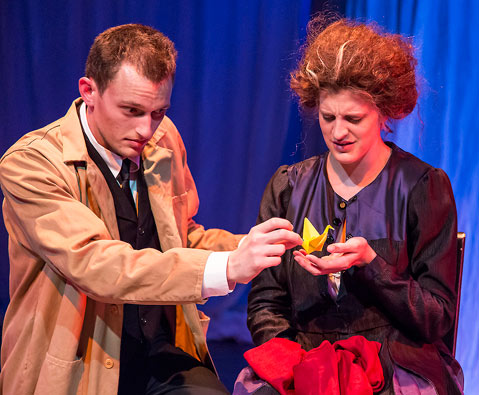Piezoelectric Love at UCSB’s Performing Arts Theatre
UCSB Theater Premieres Piezoelectric Love: The (half) Life of Marie Curie

This ambitious new play revolves around the concept of “unfinalizability,” defined as the degree to which an individual life resists total representation. The word “half” in its subtitle — The (half) Life of Marie Curie — specifically acknowledges that Piezoelectric Love is a consciously “unfinal” version of its subject. And this is not just because there is no one complete and total way to describe the life of Marie Curie; it also reflects the fact that her multiple stories are not yet over. At the center of this sprawling two-and-a-half-hour production, there’s the iconic image of Marie Curie (Kelli Coleman-Moore in a fine and moving performance), but due to the nature of the material and the methods chosen to represent it here, that center does not always hold.
It’s not so much that things fall apart in Piezoelectric Love as that the stage does not always support each of its many elements and voices to the same extent. Even the modernist black-box space of UCSB’s Performing Arts Theatre, here tricked out with extended fabric screens and traversed by, among other things, bicycles, Ping-Pong balls, and projections, can’t always offer the kind of capacious context that this Dostoevsky novel of a subject demands. There are great scenes, particularly between Coleman-Moore as Marie and Brian Bock as her husband, Pierre, but there are also longueurs in which earnest didacticism flattens the work’s dramatic shape and saps its forward momentum.
In the opening sequence, psychic Eusapia Palladino (Allie Granat) interacts with a chorus and appears to conjure Curie as a kind of alter-ego figure from out of their midst. A graphic dialogue introducing the deadly effects of radium on the human body then paves the way for the evening’s first detour through the conventions of vaudeville, as the lively and versatile Hasmik Anna Saakian delivers a manic barker’s pitch extolling the universal health benefits of radium. This pattern, in which dramatizations of the various personal and professional challenges that Curie confronted alternate with other, less naturalistic performances, then repeats in a variety of ways throughout the next two acts. Some of the ironic mash-ups, such as the trio of Granat, Hollie Sokol, and Megan Caniglia singing the song “Radium Bing!” in Act I, were delightful, while others, like the particle physics demonstration dance, seemed to exist mostly in order to give the cast something else to do.
Acts II and III range widely — taking in Hiroshima, the Manhattan Project, the experiences of young women studying science at UCSB today, and Pierre Curie’s imaginary return from the dead — and do so with a repertoire of equipment and techniques that includes everything from clown noses to Albert Einstein riding a bike. Although some of the show’s ironies feel long on sincerity and short on nuance, whenever Coleman-Moore steps onstage as Marie, her face haloed by a crown of unforgettable Bride of Frankenstein hair, these loose particles regain the charge of Curie’s courageous and curious (half) life.



